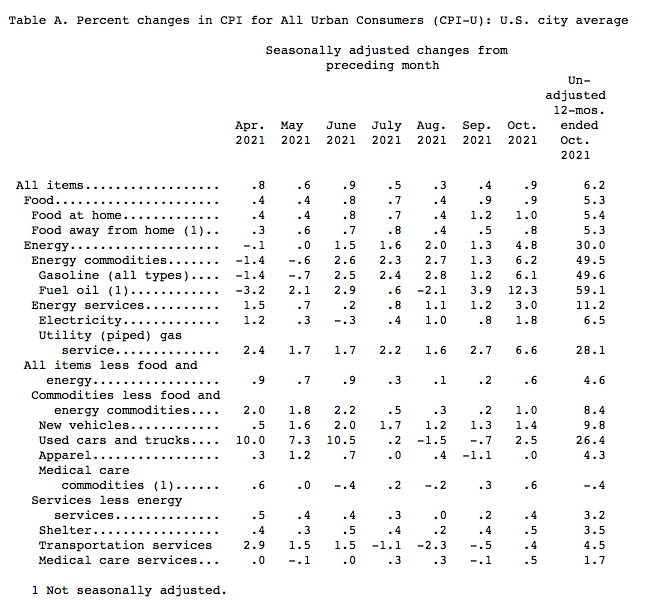The costs of goods and services rose at above-normal rates again in October, according to new federal economic data released Tuesday and Wednesday.
The Producer Price Index tracked by the Bureau of Labor Statistics, which measures wholesale prices, grew 0.6% in October. That puts the index on two straight months of an annual gain of 8.6%, the highest level on records dating back to 2010.
The Consumer Price Index released this morning increased 6.2% from a year ago in October, the most since December 1990. The one-month gain in the index of 0.9% was significantly higher than economists had expected. On average, they had forecast just a 0.6% gain, according to a Dow Jones survey.
Rising energy prices contributed significantly to the CPI change, with energy overall increasing 4.8% and an index of gasoline prices increasing 6.1%.
But the inflation was “broad-based,” going beyond just energy, the Bureau of Labor Statistics said in a news release. “The monthly all-items seasonally adjusted increase was broad-based, with increases in the indexes for energy, shelter, food, used cars and trucks, and new vehicles among the larger contributors.”
Core inflation, stripping out food and energy, increased 4.6%, the fastest gain since August 1991.
On the wholesale side, prices increased notably for plastic resins, freight and warehousing services, and construction in particular.
All of those are components of the Producer Price Index. “Prices for final demand construction advanced 6.6%” in just October, BLS stated. From a year ago, construction costs are up 12.3%.
The inflation stems in part from a money-printing policy of the Federal Reserve, the nation’s central bank. The policy began last year to inject more liquidity into the economy to support economic recovery from the pandemic. Although expansion of the money supply isn’t the only factor affecting inflation, it tends to reduce the value of the dollar in comparison to commodities like oil, steel, and agricultural products, as well as finished products.
In recent months, as Fed officials were confronted with mounting evidence of inflation, they have insisted that prices will moderate in the longer term. Federal Reserve Chairman Jay Powell believes that there’s still too much slack in the labor market to justify a halt to the money-printing or the raising of interest rates.
Powell has also blamed supply chain issues that he said were temporary.
In the meantime, Republicans are blaming Congress for the rising prices, citing trillions of dollars of coronavirus relief, much of which is being spent after the worst of the pandemic is over, overheating the economy. “Democrats’ inflation crisis keeps getting worse,” said National Republican Congressional Committee spokesman Mike Berg. “If they go through with their plans to spend trillions of dollars on a reckless big government tax and spending spree, things will only get worse.”
On the other hand, the Biden Administration has said the inflation is only temporary and pointed to promising jobs data, suggesting that wages will be able to keep up with inflation. The latest inflation readings came just days after the Department of Labor reported that in the month of October, payroll employment increased by 531,000, surpassing expectations.

